Applying the Viable Systems Model to Improve a Histology Laboratory
VerifiedAdded on 2023/06/07
|16
|3999
|286
Report
AI Summary
This report provides an analysis of the Viable Systems Model (VSM) and its potential application within a histology laboratory. Originating from Stafford Beer's work, the VSM aims to replace inflexible, autocratic organizational structures with adaptable, recursive, and accountable systems. The report outlines a possible VSM implementation for a histology laboratory, detailing its five interconnected systems: operative functioning, coordination, control and monitoring, intelligence, and policy making. It then discusses potential faults and necessary changes, such as prioritizing workforce welfare alongside viability. The report concludes that while the VSM offers a valuable framework for enhancing managerial functioning and adaptability to external market changes, it requires further modifications to address the dynamic and humane aspects of modern workplaces. The author also provides a diagrammatic representation of the Viable Systems Model for a Histology Laboratory.
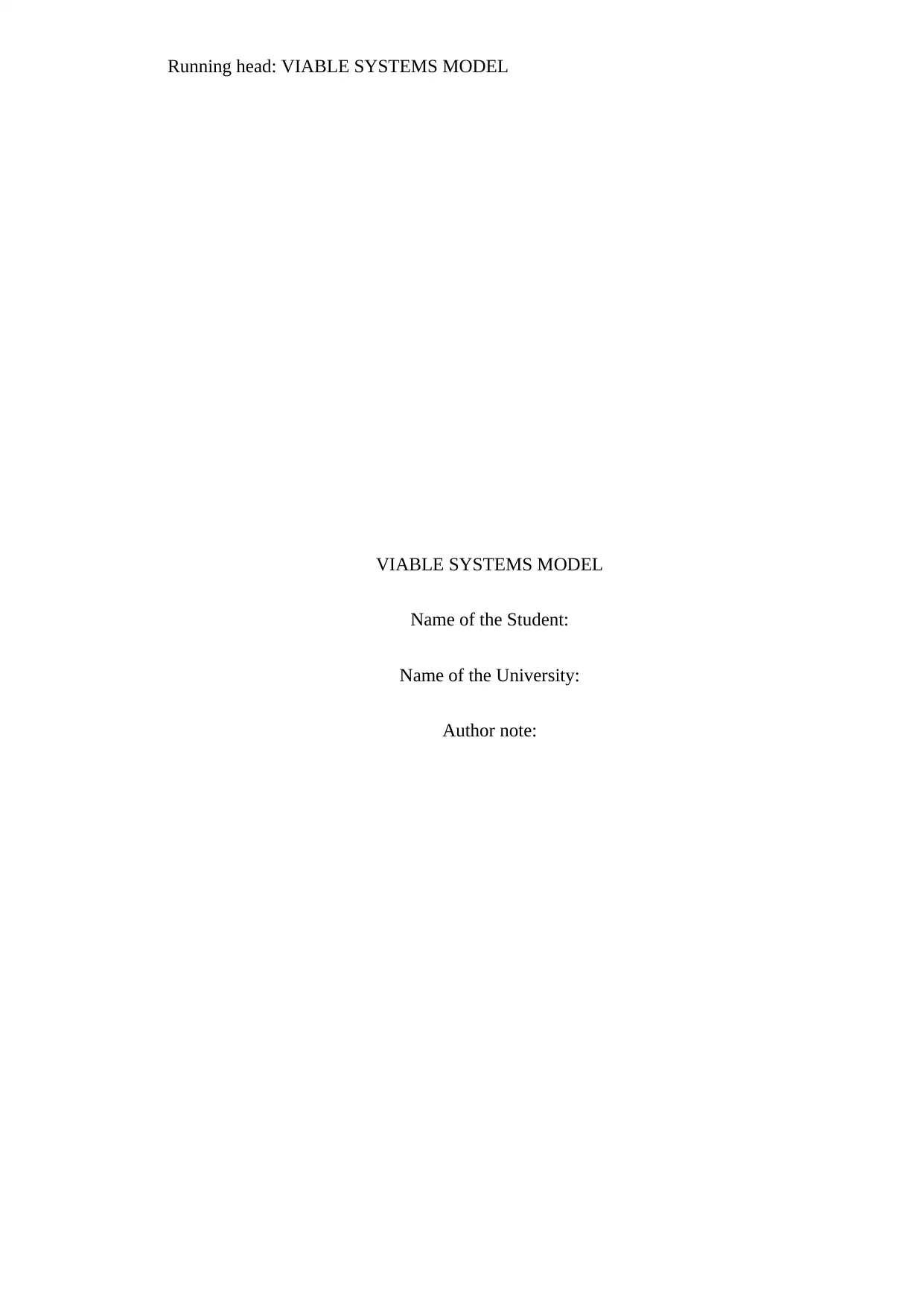
Running head: VIABLE SYSTEMS MODEL
VIABLE SYSTEMS MODEL
Name of the Student:
Name of the University:
Author note:
VIABLE SYSTEMS MODEL
Name of the Student:
Name of the University:
Author note:
Paraphrase This Document
Need a fresh take? Get an instant paraphrase of this document with our AI Paraphraser
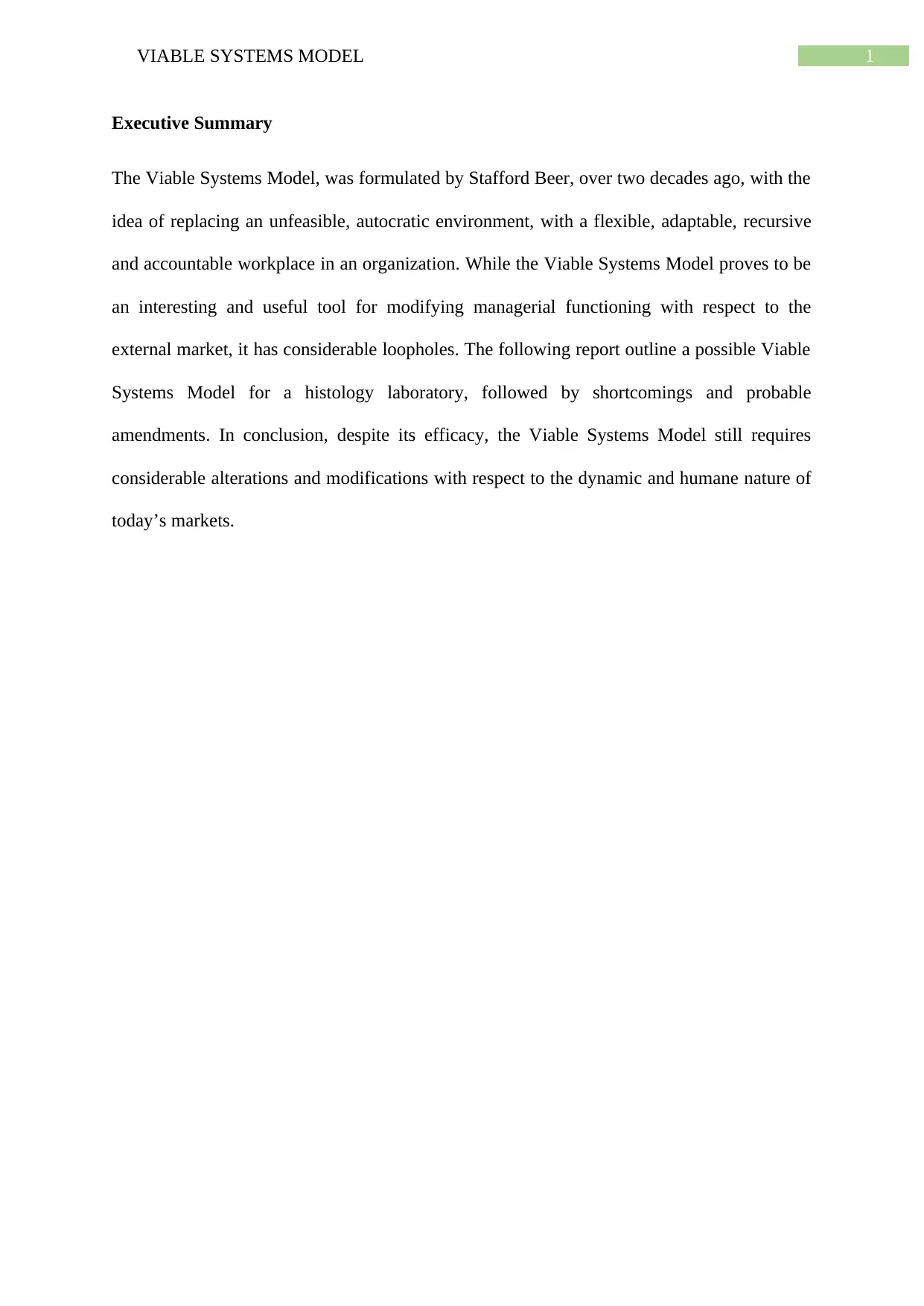
1VIABLE SYSTEMS MODEL
Executive Summary
The Viable Systems Model, was formulated by Stafford Beer, over two decades ago, with the
idea of replacing an unfeasible, autocratic environment, with a flexible, adaptable, recursive
and accountable workplace in an organization. While the Viable Systems Model proves to be
an interesting and useful tool for modifying managerial functioning with respect to the
external market, it has considerable loopholes. The following report outline a possible Viable
Systems Model for a histology laboratory, followed by shortcomings and probable
amendments. In conclusion, despite its efficacy, the Viable Systems Model still requires
considerable alterations and modifications with respect to the dynamic and humane nature of
today’s markets.
Executive Summary
The Viable Systems Model, was formulated by Stafford Beer, over two decades ago, with the
idea of replacing an unfeasible, autocratic environment, with a flexible, adaptable, recursive
and accountable workplace in an organization. While the Viable Systems Model proves to be
an interesting and useful tool for modifying managerial functioning with respect to the
external market, it has considerable loopholes. The following report outline a possible Viable
Systems Model for a histology laboratory, followed by shortcomings and probable
amendments. In conclusion, despite its efficacy, the Viable Systems Model still requires
considerable alterations and modifications with respect to the dynamic and humane nature of
today’s markets.
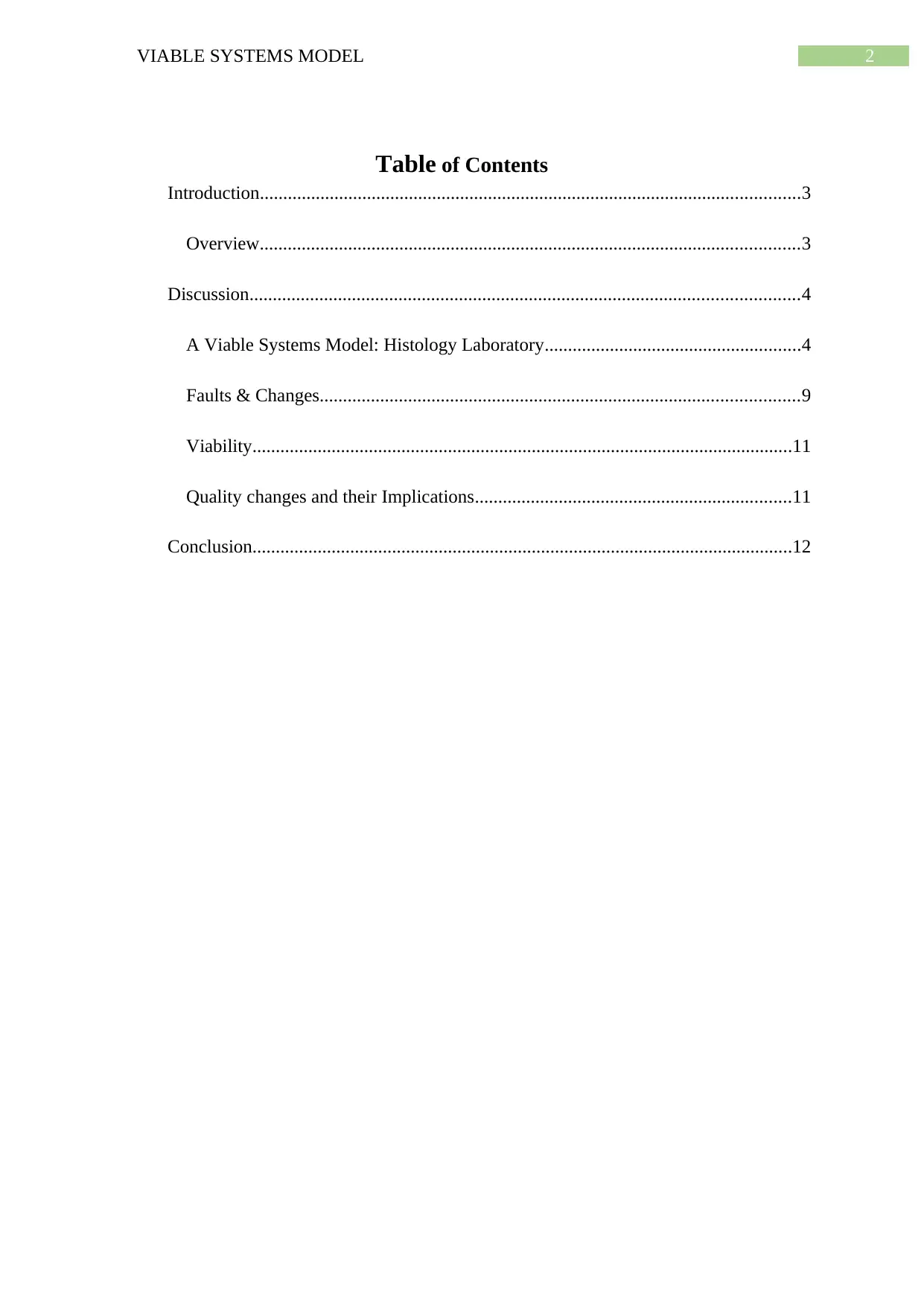
2VIABLE SYSTEMS MODEL
Table of Contents
Introduction....................................................................................................................3
Overview....................................................................................................................3
Discussion......................................................................................................................4
A Viable Systems Model: Histology Laboratory.......................................................4
Faults & Changes.......................................................................................................9
Viability....................................................................................................................11
Quality changes and their Implications....................................................................11
Conclusion....................................................................................................................12
Table of Contents
Introduction....................................................................................................................3
Overview....................................................................................................................3
Discussion......................................................................................................................4
A Viable Systems Model: Histology Laboratory.......................................................4
Faults & Changes.......................................................................................................9
Viability....................................................................................................................11
Quality changes and their Implications....................................................................11
Conclusion....................................................................................................................12
⊘ This is a preview!⊘
Do you want full access?
Subscribe today to unlock all pages.

Trusted by 1+ million students worldwide
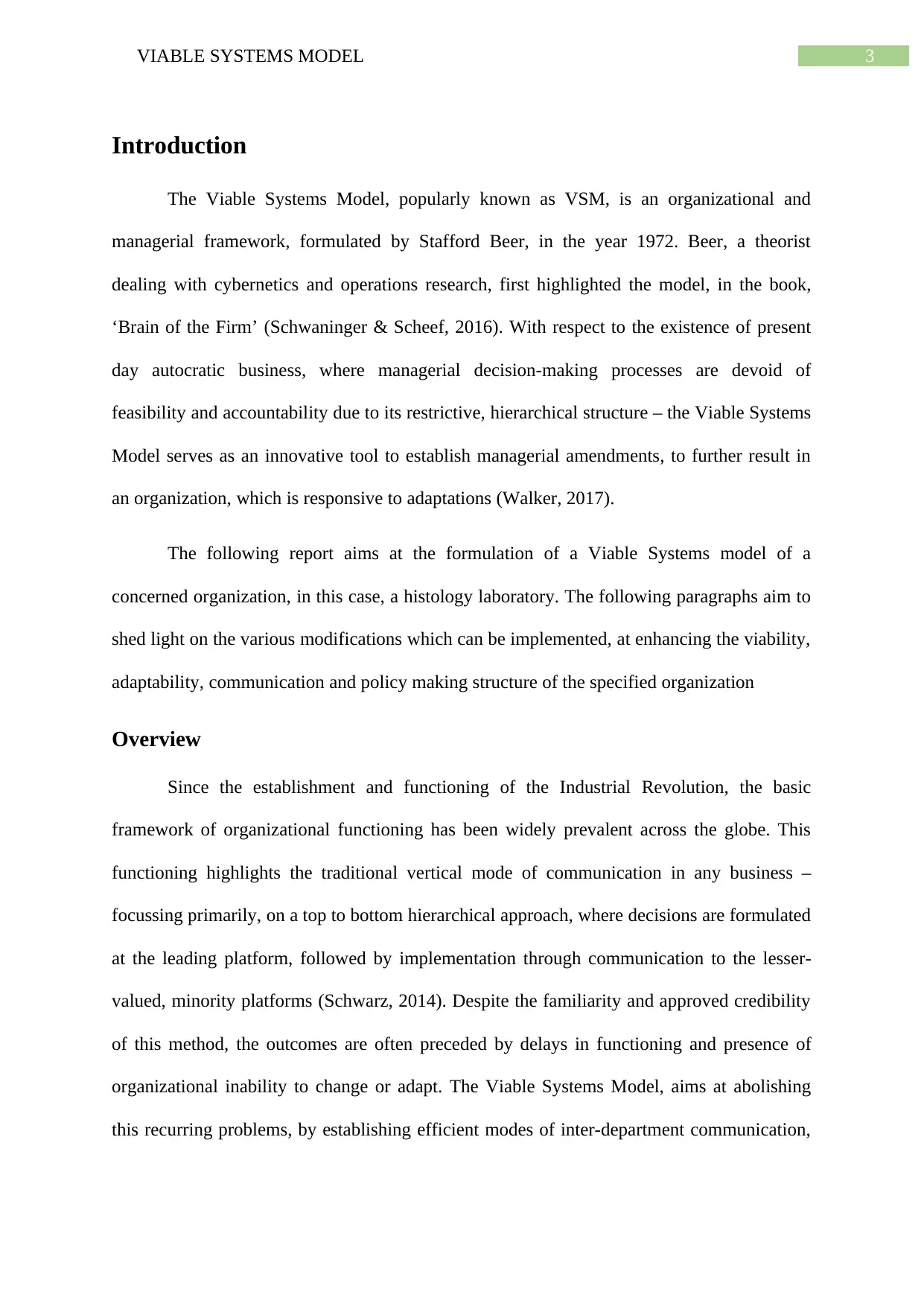
3VIABLE SYSTEMS MODEL
Introduction
The Viable Systems Model, popularly known as VSM, is an organizational and
managerial framework, formulated by Stafford Beer, in the year 1972. Beer, a theorist
dealing with cybernetics and operations research, first highlighted the model, in the book,
‘Brain of the Firm’ (Schwaninger & Scheef, 2016). With respect to the existence of present
day autocratic business, where managerial decision-making processes are devoid of
feasibility and accountability due to its restrictive, hierarchical structure – the Viable Systems
Model serves as an innovative tool to establish managerial amendments, to further result in
an organization, which is responsive to adaptations (Walker, 2017).
The following report aims at the formulation of a Viable Systems model of a
concerned organization, in this case, a histology laboratory. The following paragraphs aim to
shed light on the various modifications which can be implemented, at enhancing the viability,
adaptability, communication and policy making structure of the specified organization
Overview
Since the establishment and functioning of the Industrial Revolution, the basic
framework of organizational functioning has been widely prevalent across the globe. This
functioning highlights the traditional vertical mode of communication in any business –
focussing primarily, on a top to bottom hierarchical approach, where decisions are formulated
at the leading platform, followed by implementation through communication to the lesser-
valued, minority platforms (Schwarz, 2014). Despite the familiarity and approved credibility
of this method, the outcomes are often preceded by delays in functioning and presence of
organizational inability to change or adapt. The Viable Systems Model, aims at abolishing
this recurring problems, by establishing efficient modes of inter-department communication,
Introduction
The Viable Systems Model, popularly known as VSM, is an organizational and
managerial framework, formulated by Stafford Beer, in the year 1972. Beer, a theorist
dealing with cybernetics and operations research, first highlighted the model, in the book,
‘Brain of the Firm’ (Schwaninger & Scheef, 2016). With respect to the existence of present
day autocratic business, where managerial decision-making processes are devoid of
feasibility and accountability due to its restrictive, hierarchical structure – the Viable Systems
Model serves as an innovative tool to establish managerial amendments, to further result in
an organization, which is responsive to adaptations (Walker, 2017).
The following report aims at the formulation of a Viable Systems model of a
concerned organization, in this case, a histology laboratory. The following paragraphs aim to
shed light on the various modifications which can be implemented, at enhancing the viability,
adaptability, communication and policy making structure of the specified organization
Overview
Since the establishment and functioning of the Industrial Revolution, the basic
framework of organizational functioning has been widely prevalent across the globe. This
functioning highlights the traditional vertical mode of communication in any business –
focussing primarily, on a top to bottom hierarchical approach, where decisions are formulated
at the leading platform, followed by implementation through communication to the lesser-
valued, minority platforms (Schwarz, 2014). Despite the familiarity and approved credibility
of this method, the outcomes are often preceded by delays in functioning and presence of
organizational inability to change or adapt. The Viable Systems Model, aims at abolishing
this recurring problems, by establishing efficient modes of inter-department communication,
Paraphrase This Document
Need a fresh take? Get an instant paraphrase of this document with our AI Paraphraser

4VIABLE SYSTEMS MODEL
followed by rapid adaptability to change in accordance to the external environment (Resendiz
et al., 2017).
Discussion
Prior to development of a Viable Systems Model, there must be considerable
acquaintance regarding its key components, primarily (Puche et al., 2016):
Complexity: Viewing organizations as a collaborative system of minor networks,
each with its own autocratic functioning and the presence of inter-departmental
communication with each other.
Recursion: The presence of minor sub-parts of an organization, which further can be
divided into increasingly minor sub-parts, each with their own separate set of
independent functioning.
Viability: The capability of an organisation and each of its components to work with
success and efficiency.
A Viable Systems Model: Histology Laboratory
In accordance to development of a Viable Systems Model, the presence of five
independent yet interconnected systems are acknowledge, each with its own unique
functioning. The first three systems are primarily concerned with the present functioning
capabilities of an organization, where the fourth system deals with its response to external
amendments occurring in the surrounding vicinity. The final fifth system operates as the
mediating force between these systems, establishing coordination between the present
functioning and the future possibilities of the organization, and aiming for maintenance of
harmony in order to sustain its viability (Gallego & Garcia, 2018).
followed by rapid adaptability to change in accordance to the external environment (Resendiz
et al., 2017).
Discussion
Prior to development of a Viable Systems Model, there must be considerable
acquaintance regarding its key components, primarily (Puche et al., 2016):
Complexity: Viewing organizations as a collaborative system of minor networks,
each with its own autocratic functioning and the presence of inter-departmental
communication with each other.
Recursion: The presence of minor sub-parts of an organization, which further can be
divided into increasingly minor sub-parts, each with their own separate set of
independent functioning.
Viability: The capability of an organisation and each of its components to work with
success and efficiency.
A Viable Systems Model: Histology Laboratory
In accordance to development of a Viable Systems Model, the presence of five
independent yet interconnected systems are acknowledge, each with its own unique
functioning. The first three systems are primarily concerned with the present functioning
capabilities of an organization, where the fourth system deals with its response to external
amendments occurring in the surrounding vicinity. The final fifth system operates as the
mediating force between these systems, establishing coordination between the present
functioning and the future possibilities of the organization, and aiming for maintenance of
harmony in order to sustain its viability (Gallego & Garcia, 2018).
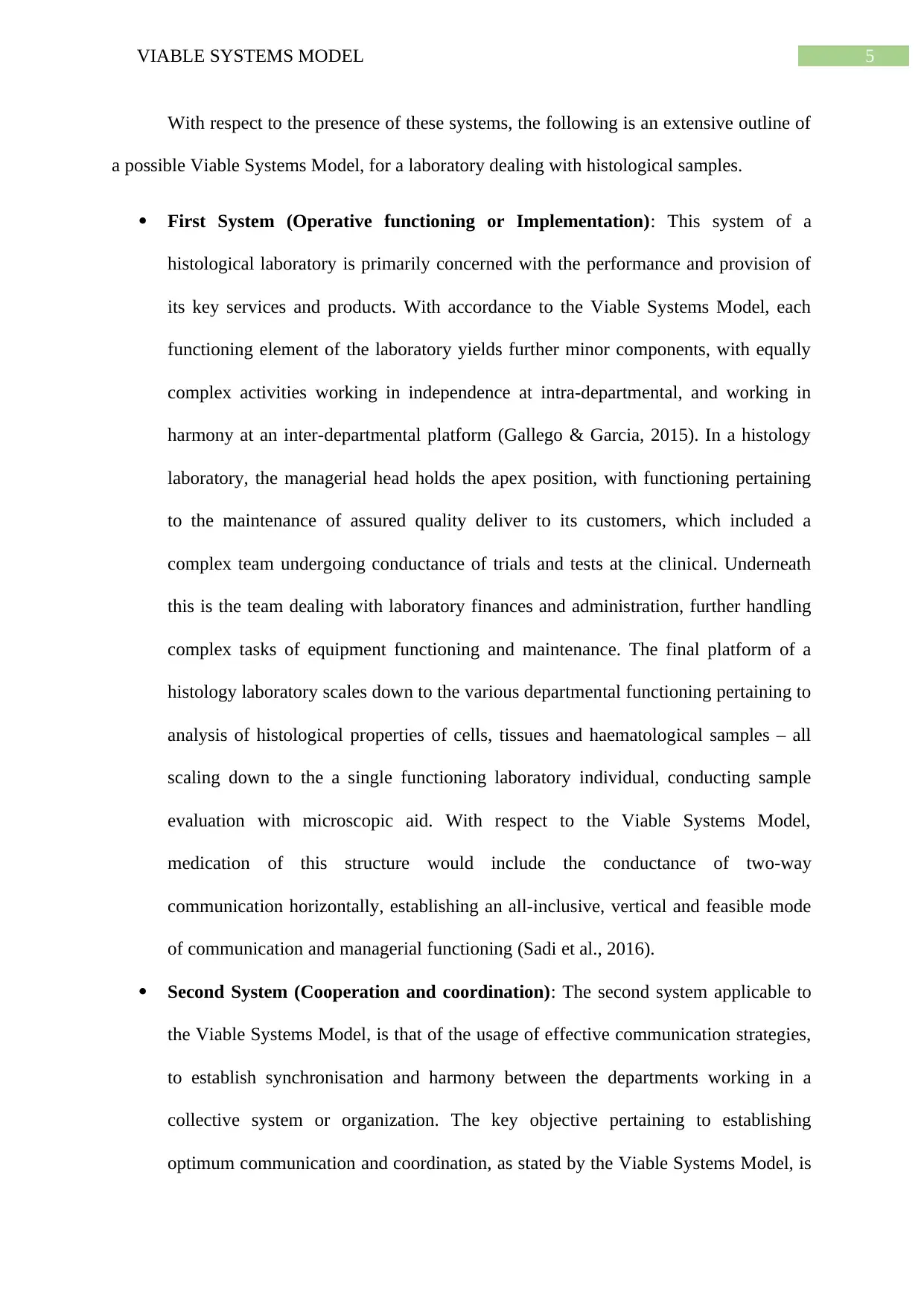
5VIABLE SYSTEMS MODEL
With respect to the presence of these systems, the following is an extensive outline of
a possible Viable Systems Model, for a laboratory dealing with histological samples.
First System (Operative functioning or Implementation): This system of a
histological laboratory is primarily concerned with the performance and provision of
its key services and products. With accordance to the Viable Systems Model, each
functioning element of the laboratory yields further minor components, with equally
complex activities working in independence at intra-departmental, and working in
harmony at an inter-departmental platform (Gallego & Garcia, 2015). In a histology
laboratory, the managerial head holds the apex position, with functioning pertaining
to the maintenance of assured quality deliver to its customers, which included a
complex team undergoing conductance of trials and tests at the clinical. Underneath
this is the team dealing with laboratory finances and administration, further handling
complex tasks of equipment functioning and maintenance. The final platform of a
histology laboratory scales down to the various departmental functioning pertaining to
analysis of histological properties of cells, tissues and haematological samples – all
scaling down to the a single functioning laboratory individual, conducting sample
evaluation with microscopic aid. With respect to the Viable Systems Model,
medication of this structure would include the conductance of two-way
communication horizontally, establishing an all-inclusive, vertical and feasible mode
of communication and managerial functioning (Sadi et al., 2016).
Second System (Cooperation and coordination): The second system applicable to
the Viable Systems Model, is that of the usage of effective communication strategies,
to establish synchronisation and harmony between the departments working in a
collective system or organization. The key objective pertaining to establishing
optimum communication and coordination, as stated by the Viable Systems Model, is
With respect to the presence of these systems, the following is an extensive outline of
a possible Viable Systems Model, for a laboratory dealing with histological samples.
First System (Operative functioning or Implementation): This system of a
histological laboratory is primarily concerned with the performance and provision of
its key services and products. With accordance to the Viable Systems Model, each
functioning element of the laboratory yields further minor components, with equally
complex activities working in independence at intra-departmental, and working in
harmony at an inter-departmental platform (Gallego & Garcia, 2015). In a histology
laboratory, the managerial head holds the apex position, with functioning pertaining
to the maintenance of assured quality deliver to its customers, which included a
complex team undergoing conductance of trials and tests at the clinical. Underneath
this is the team dealing with laboratory finances and administration, further handling
complex tasks of equipment functioning and maintenance. The final platform of a
histology laboratory scales down to the various departmental functioning pertaining to
analysis of histological properties of cells, tissues and haematological samples – all
scaling down to the a single functioning laboratory individual, conducting sample
evaluation with microscopic aid. With respect to the Viable Systems Model,
medication of this structure would include the conductance of two-way
communication horizontally, establishing an all-inclusive, vertical and feasible mode
of communication and managerial functioning (Sadi et al., 2016).
Second System (Cooperation and coordination): The second system applicable to
the Viable Systems Model, is that of the usage of effective communication strategies,
to establish synchronisation and harmony between the departments working in a
collective system or organization. The key objective pertaining to establishing
optimum communication and coordination, as stated by the Viable Systems Model, is
⊘ This is a preview!⊘
Do you want full access?
Subscribe today to unlock all pages.

Trusted by 1+ million students worldwide
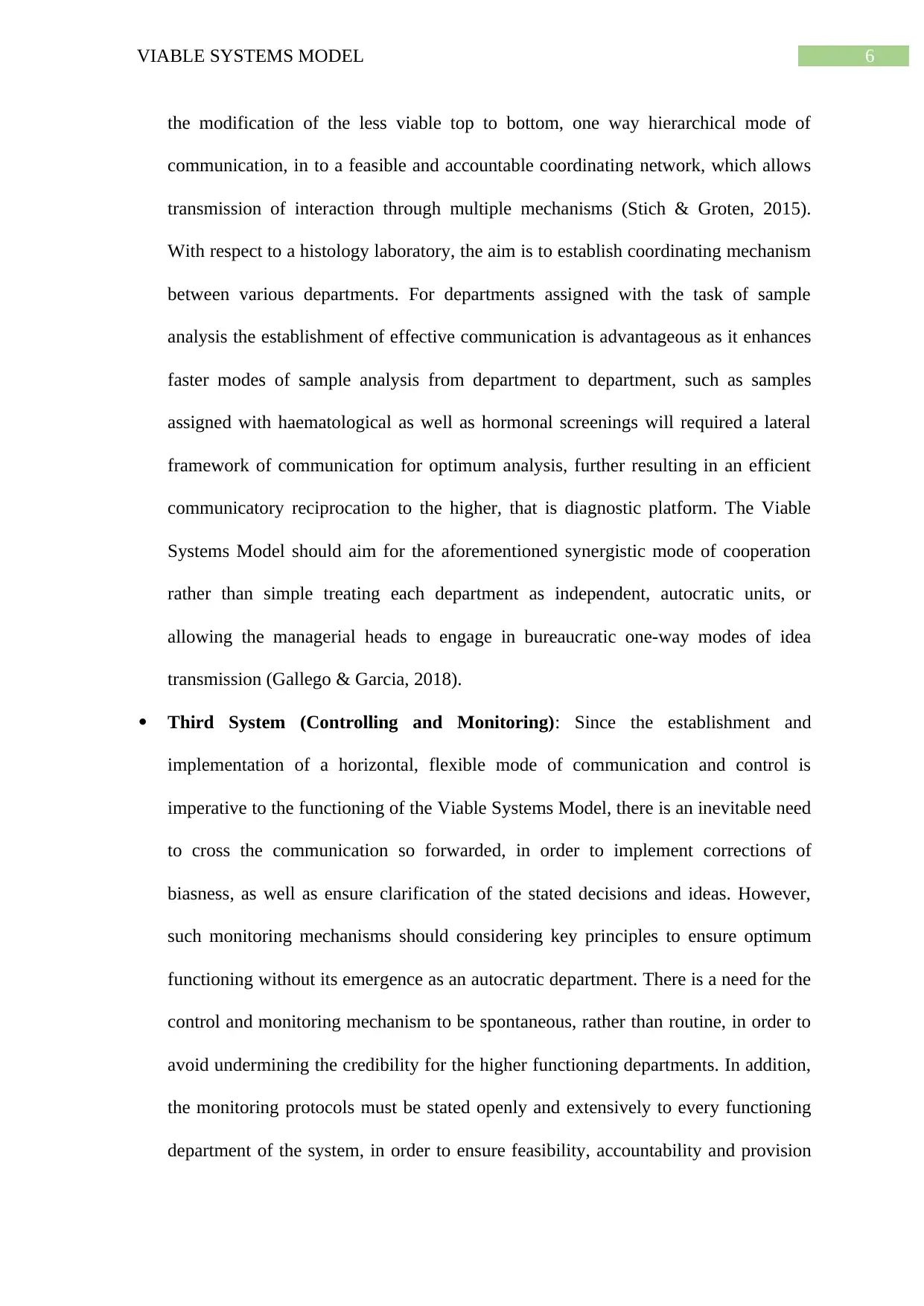
6VIABLE SYSTEMS MODEL
the modification of the less viable top to bottom, one way hierarchical mode of
communication, in to a feasible and accountable coordinating network, which allows
transmission of interaction through multiple mechanisms (Stich & Groten, 2015).
With respect to a histology laboratory, the aim is to establish coordinating mechanism
between various departments. For departments assigned with the task of sample
analysis the establishment of effective communication is advantageous as it enhances
faster modes of sample analysis from department to department, such as samples
assigned with haematological as well as hormonal screenings will required a lateral
framework of communication for optimum analysis, further resulting in an efficient
communicatory reciprocation to the higher, that is diagnostic platform. The Viable
Systems Model should aim for the aforementioned synergistic mode of cooperation
rather than simple treating each department as independent, autocratic units, or
allowing the managerial heads to engage in bureaucratic one-way modes of idea
transmission (Gallego & Garcia, 2018).
Third System (Controlling and Monitoring): Since the establishment and
implementation of a horizontal, flexible mode of communication and control is
imperative to the functioning of the Viable Systems Model, there is an inevitable need
to cross the communication so forwarded, in order to implement corrections of
biasness, as well as ensure clarification of the stated decisions and ideas. However,
such monitoring mechanisms should considering key principles to ensure optimum
functioning without its emergence as an autocratic department. There is a need for the
control and monitoring mechanism to be spontaneous, rather than routine, in order to
avoid undermining the credibility for the higher functioning departments. In addition,
the monitoring protocols must be stated openly and extensively to every functioning
department of the system, in order to ensure feasibility, accountability and provision
the modification of the less viable top to bottom, one way hierarchical mode of
communication, in to a feasible and accountable coordinating network, which allows
transmission of interaction through multiple mechanisms (Stich & Groten, 2015).
With respect to a histology laboratory, the aim is to establish coordinating mechanism
between various departments. For departments assigned with the task of sample
analysis the establishment of effective communication is advantageous as it enhances
faster modes of sample analysis from department to department, such as samples
assigned with haematological as well as hormonal screenings will required a lateral
framework of communication for optimum analysis, further resulting in an efficient
communicatory reciprocation to the higher, that is diagnostic platform. The Viable
Systems Model should aim for the aforementioned synergistic mode of cooperation
rather than simple treating each department as independent, autocratic units, or
allowing the managerial heads to engage in bureaucratic one-way modes of idea
transmission (Gallego & Garcia, 2018).
Third System (Controlling and Monitoring): Since the establishment and
implementation of a horizontal, flexible mode of communication and control is
imperative to the functioning of the Viable Systems Model, there is an inevitable need
to cross the communication so forwarded, in order to implement corrections of
biasness, as well as ensure clarification of the stated decisions and ideas. However,
such monitoring mechanisms should considering key principles to ensure optimum
functioning without its emergence as an autocratic department. There is a need for the
control and monitoring mechanism to be spontaneous, rather than routine, in order to
avoid undermining the credibility for the higher functioning departments. In addition,
the monitoring protocols must be stated openly and extensively to every functioning
department of the system, in order to ensure feasibility, accountability and provision
Paraphrase This Document
Need a fresh take? Get an instant paraphrase of this document with our AI Paraphraser
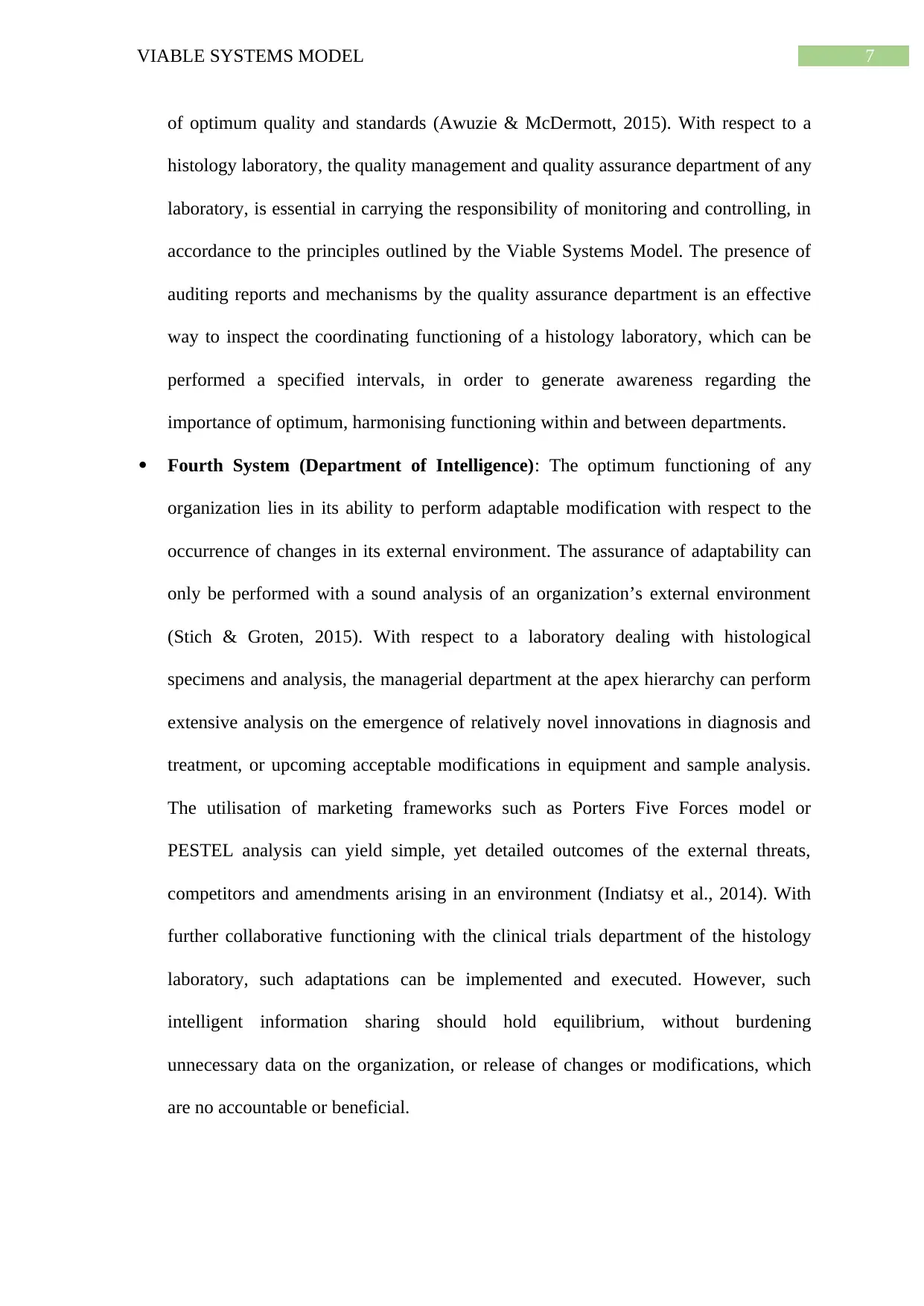
7VIABLE SYSTEMS MODEL
of optimum quality and standards (Awuzie & McDermott, 2015). With respect to a
histology laboratory, the quality management and quality assurance department of any
laboratory, is essential in carrying the responsibility of monitoring and controlling, in
accordance to the principles outlined by the Viable Systems Model. The presence of
auditing reports and mechanisms by the quality assurance department is an effective
way to inspect the coordinating functioning of a histology laboratory, which can be
performed a specified intervals, in order to generate awareness regarding the
importance of optimum, harmonising functioning within and between departments.
Fourth System (Department of Intelligence): The optimum functioning of any
organization lies in its ability to perform adaptable modification with respect to the
occurrence of changes in its external environment. The assurance of adaptability can
only be performed with a sound analysis of an organization’s external environment
(Stich & Groten, 2015). With respect to a laboratory dealing with histological
specimens and analysis, the managerial department at the apex hierarchy can perform
extensive analysis on the emergence of relatively novel innovations in diagnosis and
treatment, or upcoming acceptable modifications in equipment and sample analysis.
The utilisation of marketing frameworks such as Porters Five Forces model or
PESTEL analysis can yield simple, yet detailed outcomes of the external threats,
competitors and amendments arising in an environment (Indiatsy et al., 2014). With
further collaborative functioning with the clinical trials department of the histology
laboratory, such adaptations can be implemented and executed. However, such
intelligent information sharing should hold equilibrium, without burdening
unnecessary data on the organization, or release of changes or modifications, which
are no accountable or beneficial.
of optimum quality and standards (Awuzie & McDermott, 2015). With respect to a
histology laboratory, the quality management and quality assurance department of any
laboratory, is essential in carrying the responsibility of monitoring and controlling, in
accordance to the principles outlined by the Viable Systems Model. The presence of
auditing reports and mechanisms by the quality assurance department is an effective
way to inspect the coordinating functioning of a histology laboratory, which can be
performed a specified intervals, in order to generate awareness regarding the
importance of optimum, harmonising functioning within and between departments.
Fourth System (Department of Intelligence): The optimum functioning of any
organization lies in its ability to perform adaptable modification with respect to the
occurrence of changes in its external environment. The assurance of adaptability can
only be performed with a sound analysis of an organization’s external environment
(Stich & Groten, 2015). With respect to a laboratory dealing with histological
specimens and analysis, the managerial department at the apex hierarchy can perform
extensive analysis on the emergence of relatively novel innovations in diagnosis and
treatment, or upcoming acceptable modifications in equipment and sample analysis.
The utilisation of marketing frameworks such as Porters Five Forces model or
PESTEL analysis can yield simple, yet detailed outcomes of the external threats,
competitors and amendments arising in an environment (Indiatsy et al., 2014). With
further collaborative functioning with the clinical trials department of the histology
laboratory, such adaptations can be implemented and executed. However, such
intelligent information sharing should hold equilibrium, without burdening
unnecessary data on the organization, or release of changes or modifications, which
are no accountable or beneficial.
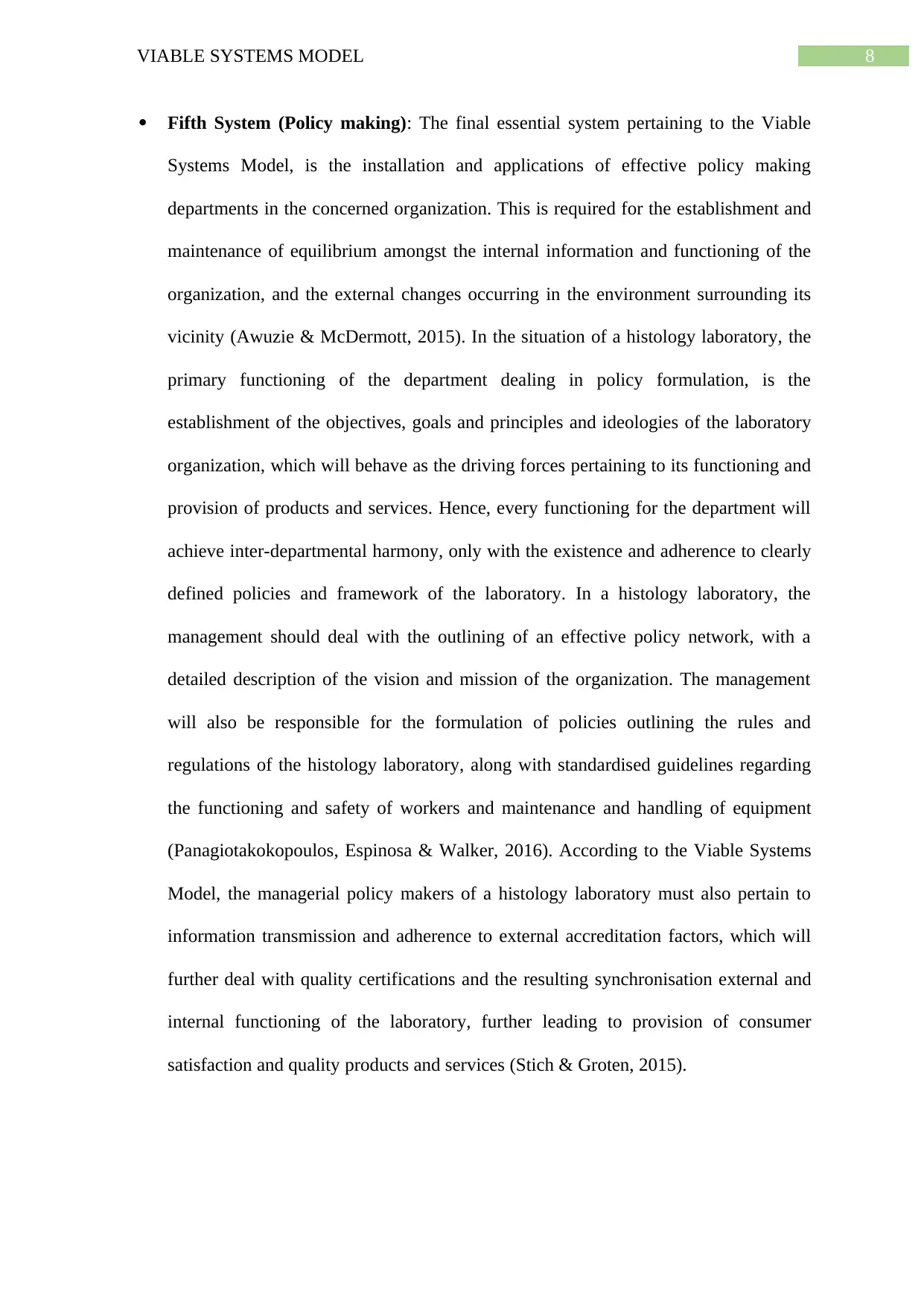
8VIABLE SYSTEMS MODEL
Fifth System (Policy making): The final essential system pertaining to the Viable
Systems Model, is the installation and applications of effective policy making
departments in the concerned organization. This is required for the establishment and
maintenance of equilibrium amongst the internal information and functioning of the
organization, and the external changes occurring in the environment surrounding its
vicinity (Awuzie & McDermott, 2015). In the situation of a histology laboratory, the
primary functioning of the department dealing in policy formulation, is the
establishment of the objectives, goals and principles and ideologies of the laboratory
organization, which will behave as the driving forces pertaining to its functioning and
provision of products and services. Hence, every functioning for the department will
achieve inter-departmental harmony, only with the existence and adherence to clearly
defined policies and framework of the laboratory. In a histology laboratory, the
management should deal with the outlining of an effective policy network, with a
detailed description of the vision and mission of the organization. The management
will also be responsible for the formulation of policies outlining the rules and
regulations of the histology laboratory, along with standardised guidelines regarding
the functioning and safety of workers and maintenance and handling of equipment
(Panagiotakokopoulos, Espinosa & Walker, 2016). According to the Viable Systems
Model, the managerial policy makers of a histology laboratory must also pertain to
information transmission and adherence to external accreditation factors, which will
further deal with quality certifications and the resulting synchronisation external and
internal functioning of the laboratory, further leading to provision of consumer
satisfaction and quality products and services (Stich & Groten, 2015).
Fifth System (Policy making): The final essential system pertaining to the Viable
Systems Model, is the installation and applications of effective policy making
departments in the concerned organization. This is required for the establishment and
maintenance of equilibrium amongst the internal information and functioning of the
organization, and the external changes occurring in the environment surrounding its
vicinity (Awuzie & McDermott, 2015). In the situation of a histology laboratory, the
primary functioning of the department dealing in policy formulation, is the
establishment of the objectives, goals and principles and ideologies of the laboratory
organization, which will behave as the driving forces pertaining to its functioning and
provision of products and services. Hence, every functioning for the department will
achieve inter-departmental harmony, only with the existence and adherence to clearly
defined policies and framework of the laboratory. In a histology laboratory, the
management should deal with the outlining of an effective policy network, with a
detailed description of the vision and mission of the organization. The management
will also be responsible for the formulation of policies outlining the rules and
regulations of the histology laboratory, along with standardised guidelines regarding
the functioning and safety of workers and maintenance and handling of equipment
(Panagiotakokopoulos, Espinosa & Walker, 2016). According to the Viable Systems
Model, the managerial policy makers of a histology laboratory must also pertain to
information transmission and adherence to external accreditation factors, which will
further deal with quality certifications and the resulting synchronisation external and
internal functioning of the laboratory, further leading to provision of consumer
satisfaction and quality products and services (Stich & Groten, 2015).
⊘ This is a preview!⊘
Do you want full access?
Subscribe today to unlock all pages.

Trusted by 1+ million students worldwide
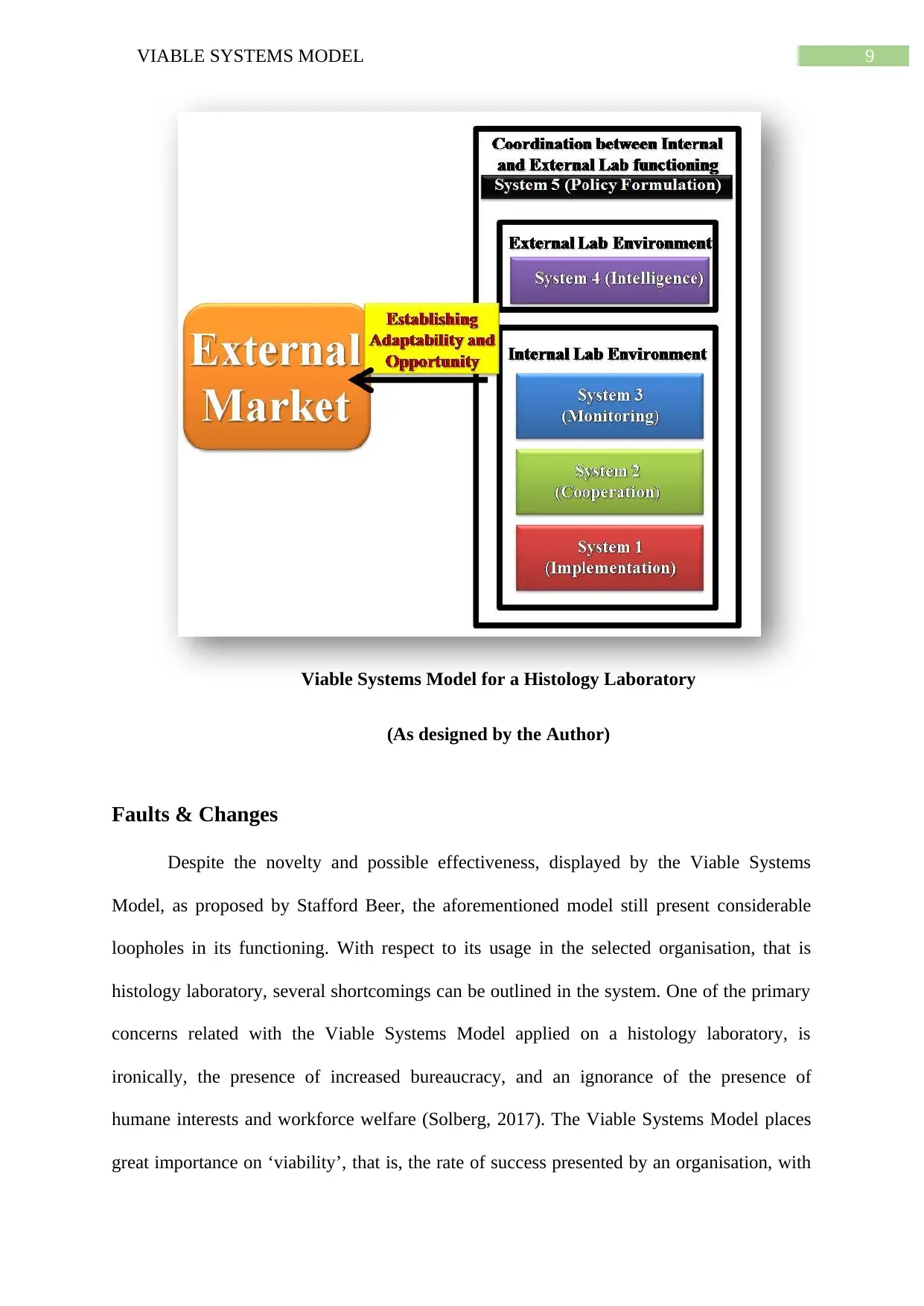
9VIABLE SYSTEMS MODEL
Faults & Changes
Despite the novelty and possible effectiveness, displayed by the Viable Systems
Model, as proposed by Stafford Beer, the aforementioned model still present considerable
loopholes in its functioning. With respect to its usage in the selected organisation, that is
histology laboratory, several shortcomings can be outlined in the system. One of the primary
concerns related with the Viable Systems Model applied on a histology laboratory, is
ironically, the presence of increased bureaucracy, and an ignorance of the presence of
humane interests and workforce welfare (Solberg, 2017). The Viable Systems Model places
great importance on ‘viability’, that is, the rate of success presented by an organisation, with
Viable Systems Model for a Histology Laboratory
(As designed by the Author)
Faults & Changes
Despite the novelty and possible effectiveness, displayed by the Viable Systems
Model, as proposed by Stafford Beer, the aforementioned model still present considerable
loopholes in its functioning. With respect to its usage in the selected organisation, that is
histology laboratory, several shortcomings can be outlined in the system. One of the primary
concerns related with the Viable Systems Model applied on a histology laboratory, is
ironically, the presence of increased bureaucracy, and an ignorance of the presence of
humane interests and workforce welfare (Solberg, 2017). The Viable Systems Model places
great importance on ‘viability’, that is, the rate of success presented by an organisation, with
Viable Systems Model for a Histology Laboratory
(As designed by the Author)
Paraphrase This Document
Need a fresh take? Get an instant paraphrase of this document with our AI Paraphraser
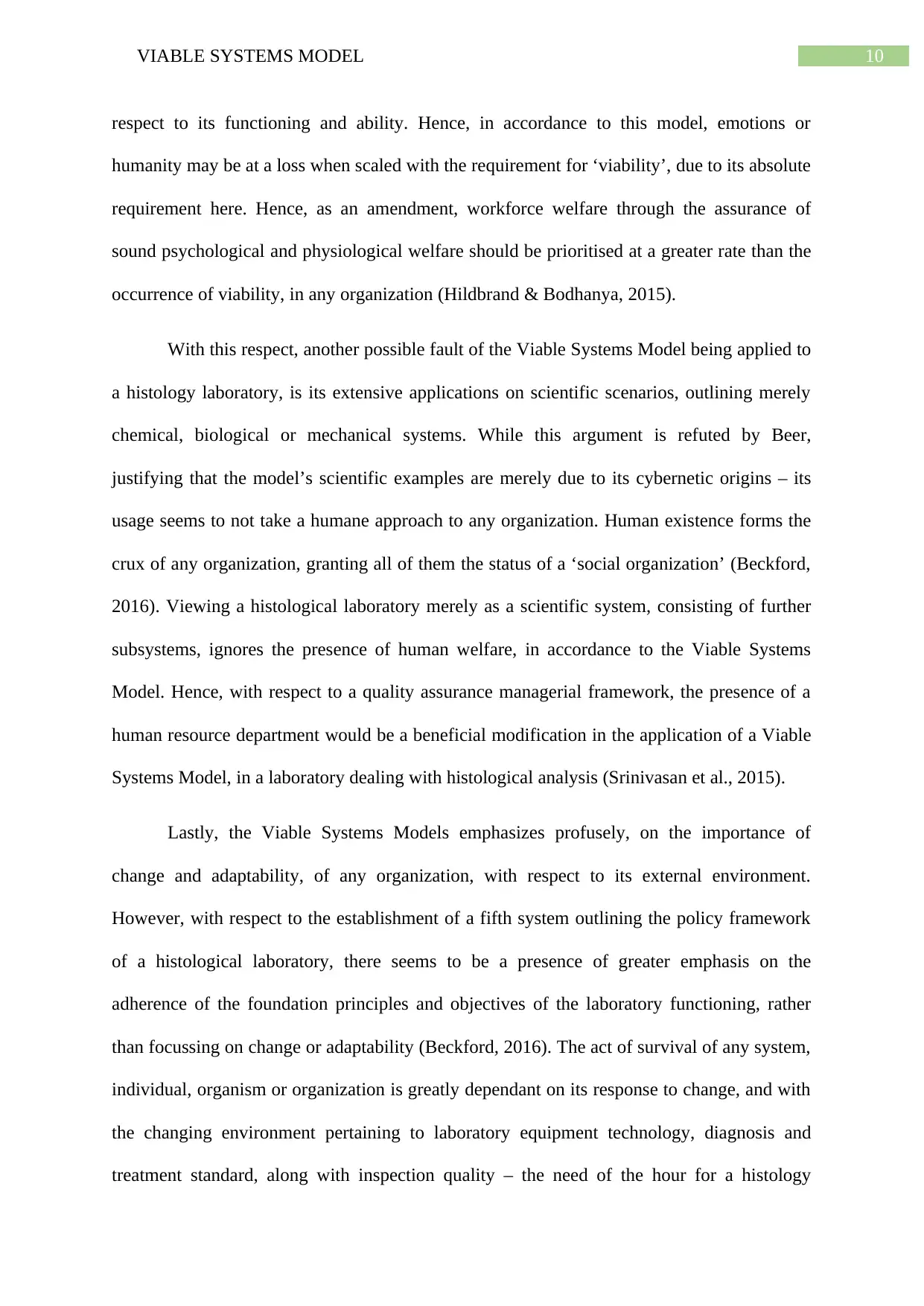
10VIABLE SYSTEMS MODEL
respect to its functioning and ability. Hence, in accordance to this model, emotions or
humanity may be at a loss when scaled with the requirement for ‘viability’, due to its absolute
requirement here. Hence, as an amendment, workforce welfare through the assurance of
sound psychological and physiological welfare should be prioritised at a greater rate than the
occurrence of viability, in any organization (Hildbrand & Bodhanya, 2015).
With this respect, another possible fault of the Viable Systems Model being applied to
a histology laboratory, is its extensive applications on scientific scenarios, outlining merely
chemical, biological or mechanical systems. While this argument is refuted by Beer,
justifying that the model’s scientific examples are merely due to its cybernetic origins – its
usage seems to not take a humane approach to any organization. Human existence forms the
crux of any organization, granting all of them the status of a ‘social organization’ (Beckford,
2016). Viewing a histological laboratory merely as a scientific system, consisting of further
subsystems, ignores the presence of human welfare, in accordance to the Viable Systems
Model. Hence, with respect to a quality assurance managerial framework, the presence of a
human resource department would be a beneficial modification in the application of a Viable
Systems Model, in a laboratory dealing with histological analysis (Srinivasan et al., 2015).
Lastly, the Viable Systems Models emphasizes profusely, on the importance of
change and adaptability, of any organization, with respect to its external environment.
However, with respect to the establishment of a fifth system outlining the policy framework
of a histological laboratory, there seems to be a presence of greater emphasis on the
adherence of the foundation principles and objectives of the laboratory functioning, rather
than focussing on change or adaptability (Beckford, 2016). The act of survival of any system,
individual, organism or organization is greatly dependant on its response to change, and with
the changing environment pertaining to laboratory equipment technology, diagnosis and
treatment standard, along with inspection quality – the need of the hour for a histology
respect to its functioning and ability. Hence, in accordance to this model, emotions or
humanity may be at a loss when scaled with the requirement for ‘viability’, due to its absolute
requirement here. Hence, as an amendment, workforce welfare through the assurance of
sound psychological and physiological welfare should be prioritised at a greater rate than the
occurrence of viability, in any organization (Hildbrand & Bodhanya, 2015).
With this respect, another possible fault of the Viable Systems Model being applied to
a histology laboratory, is its extensive applications on scientific scenarios, outlining merely
chemical, biological or mechanical systems. While this argument is refuted by Beer,
justifying that the model’s scientific examples are merely due to its cybernetic origins – its
usage seems to not take a humane approach to any organization. Human existence forms the
crux of any organization, granting all of them the status of a ‘social organization’ (Beckford,
2016). Viewing a histological laboratory merely as a scientific system, consisting of further
subsystems, ignores the presence of human welfare, in accordance to the Viable Systems
Model. Hence, with respect to a quality assurance managerial framework, the presence of a
human resource department would be a beneficial modification in the application of a Viable
Systems Model, in a laboratory dealing with histological analysis (Srinivasan et al., 2015).
Lastly, the Viable Systems Models emphasizes profusely, on the importance of
change and adaptability, of any organization, with respect to its external environment.
However, with respect to the establishment of a fifth system outlining the policy framework
of a histological laboratory, there seems to be a presence of greater emphasis on the
adherence of the foundation principles and objectives of the laboratory functioning, rather
than focussing on change or adaptability (Beckford, 2016). The act of survival of any system,
individual, organism or organization is greatly dependant on its response to change, and with
the changing environment pertaining to laboratory equipment technology, diagnosis and
treatment standard, along with inspection quality – the need of the hour for a histology
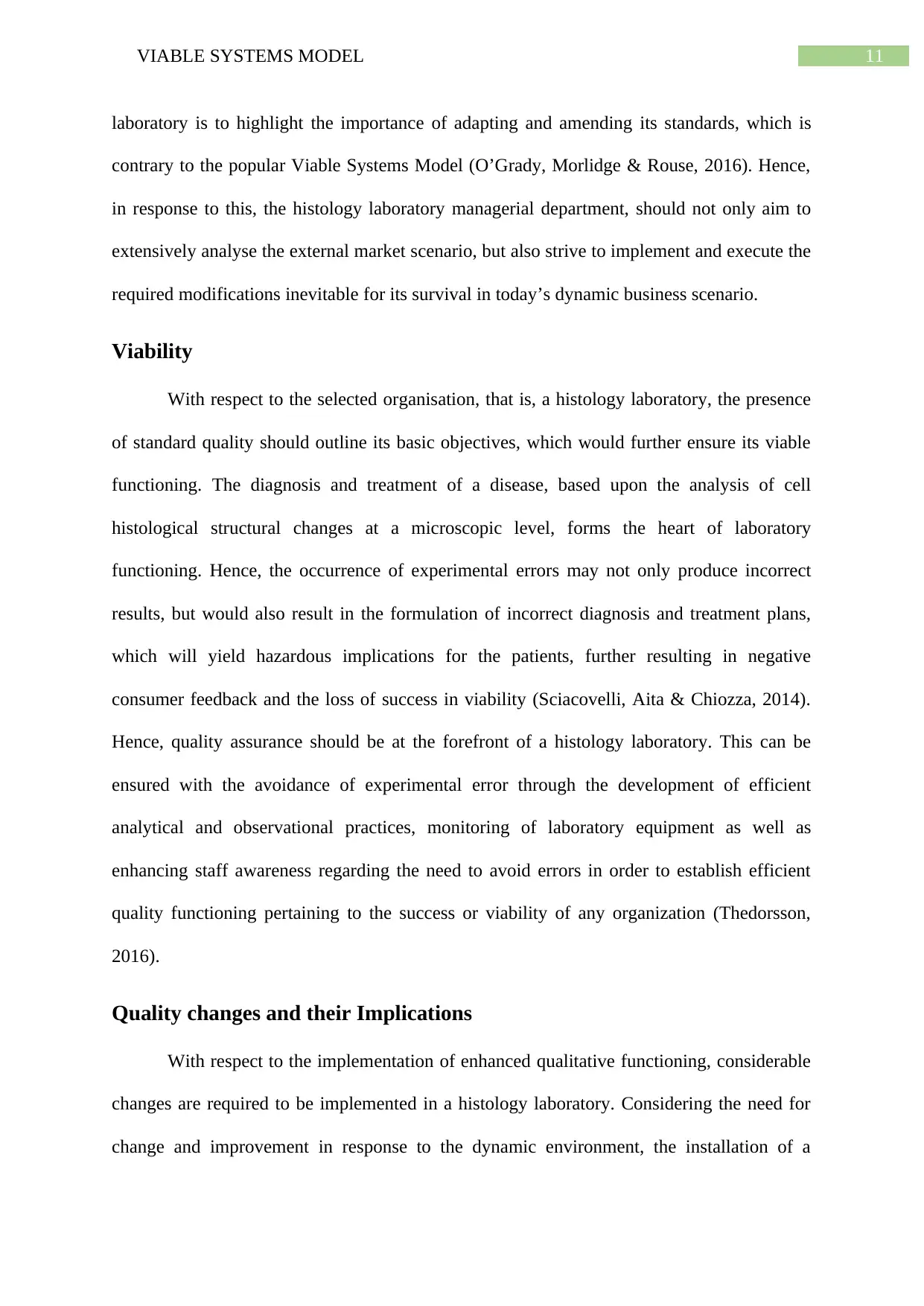
11VIABLE SYSTEMS MODEL
laboratory is to highlight the importance of adapting and amending its standards, which is
contrary to the popular Viable Systems Model (O’Grady, Morlidge & Rouse, 2016). Hence,
in response to this, the histology laboratory managerial department, should not only aim to
extensively analyse the external market scenario, but also strive to implement and execute the
required modifications inevitable for its survival in today’s dynamic business scenario.
Viability
With respect to the selected organisation, that is, a histology laboratory, the presence
of standard quality should outline its basic objectives, which would further ensure its viable
functioning. The diagnosis and treatment of a disease, based upon the analysis of cell
histological structural changes at a microscopic level, forms the heart of laboratory
functioning. Hence, the occurrence of experimental errors may not only produce incorrect
results, but would also result in the formulation of incorrect diagnosis and treatment plans,
which will yield hazardous implications for the patients, further resulting in negative
consumer feedback and the loss of success in viability (Sciacovelli, Aita & Chiozza, 2014).
Hence, quality assurance should be at the forefront of a histology laboratory. This can be
ensured with the avoidance of experimental error through the development of efficient
analytical and observational practices, monitoring of laboratory equipment as well as
enhancing staff awareness regarding the need to avoid errors in order to establish efficient
quality functioning pertaining to the success or viability of any organization (Thedorsson,
2016).
Quality changes and their Implications
With respect to the implementation of enhanced qualitative functioning, considerable
changes are required to be implemented in a histology laboratory. Considering the need for
change and improvement in response to the dynamic environment, the installation of a
laboratory is to highlight the importance of adapting and amending its standards, which is
contrary to the popular Viable Systems Model (O’Grady, Morlidge & Rouse, 2016). Hence,
in response to this, the histology laboratory managerial department, should not only aim to
extensively analyse the external market scenario, but also strive to implement and execute the
required modifications inevitable for its survival in today’s dynamic business scenario.
Viability
With respect to the selected organisation, that is, a histology laboratory, the presence
of standard quality should outline its basic objectives, which would further ensure its viable
functioning. The diagnosis and treatment of a disease, based upon the analysis of cell
histological structural changes at a microscopic level, forms the heart of laboratory
functioning. Hence, the occurrence of experimental errors may not only produce incorrect
results, but would also result in the formulation of incorrect diagnosis and treatment plans,
which will yield hazardous implications for the patients, further resulting in negative
consumer feedback and the loss of success in viability (Sciacovelli, Aita & Chiozza, 2014).
Hence, quality assurance should be at the forefront of a histology laboratory. This can be
ensured with the avoidance of experimental error through the development of efficient
analytical and observational practices, monitoring of laboratory equipment as well as
enhancing staff awareness regarding the need to avoid errors in order to establish efficient
quality functioning pertaining to the success or viability of any organization (Thedorsson,
2016).
Quality changes and their Implications
With respect to the implementation of enhanced qualitative functioning, considerable
changes are required to be implemented in a histology laboratory. Considering the need for
change and improvement in response to the dynamic environment, the installation of a
⊘ This is a preview!⊘
Do you want full access?
Subscribe today to unlock all pages.

Trusted by 1+ million students worldwide
1 out of 16